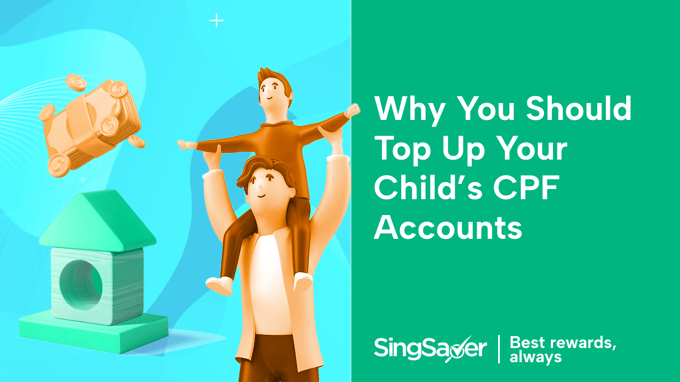Did you know you can contribute to your children’s CPF right from when their CPF accounts are opened? You can even turn them into millionaires if you pump in sufficient funds and let the money grow until it’s time for your kids to retire.
Where’s a good place to park your kids’ angbao money? A regular savings account may be the first thing that pops into your head but hold your horses — there are other better options around. For one, you can consider stashing your children’s money as well as your voluntary contribution to their CPF accounts to give them a head start in growing their CPF balances.
The Child Development Account is another one you don’t want to pass up on if you want to make every dollar work as hard as it can to help defray some of the costs of raising your little bundles of joy.
Table of contents
- Why should you voluntarily top up your children’s CPF?
- How to top up CPF Ordinary Account, Special Account and MediSave Account?
- Maximum amount you can top up
- What the various CPF accounts can be used for
- Do you really need to contribute to your children’s CPF?
- Maximising the Child Development Account
Disclaimer: The 4% p.a. interest earned for Special Account and MediSave Account has been adjusted to 4.08% p.a. from 1 Jan to 31 Mar 2024.
4 reasons why you should top up your children's CPF
#1: Leverage on relatively attractive, risk-free interest
On average, a regular savings account offers a meager base interest of 0.05% p.a without fulfilling any bonus rate requirements. If you’re looking for a good place to park your extra funds and/or your children’s angbao monies, consider leveraging on the risk-free interest offered by the CPF Ordinary Account (OA), Special Account (SA) and MediSave Account (MA).
For CPF members below the age of 55, the interest rates for the various CPF accounts hold, (fingers crossed the Government doesn’t revise interest rates downwards):
- OA: 2.5% p.a.
- SA: 4% p.a.
- MA: 4% p.a.
That’s not all. You’ll be happy to learn that the Government pays extra interest to enhance the retirement savings of Singaporeans. In particular, you can expect up to 5% interest (4%* + extra 1%) to be paid out on the first S$60,000 of combined balances (capped at S$20,000 for the OA). The extra interest received on the OA balances will go into the SA.
Just be aware that parents who contribute to their children’s CPF can’t claim tax relief for such top-ups, unless you contribute to their MediSave accounts. The funds inside are, of course, illiquid.
*based on the 12-month average yield of 10-year Singapore Government Securities (10YSGS)
Read more:
Optimise Your Income Tax, Score Better Investment Returns
Guide to Optimising Tax Efficiency in the Millionaires' Club
#2: Compound interest can make your children millionaires
You can potentially make your children millionaires if you start pumping in sufficient funds early into their SA to take advantage of the long time horizon as well as the power of compound interest — right from the moment your baby pops out.
With the current CPF SA interest rate of 4% p.a., you’ll need approximately S$112,000 to make your sweet little baby a millionaire by the time he or she turns 55. The actual lump sum amount required should be a tad less intimidating in real life considering the Government pays an extra 1% interest on the first S$60,000 of combined balances across your child’s CPF OA and SA.
💡 Pro-tip: Play around with the CPF Savings Calculator here.
According to the CPF Board’s 2020 Annual Report, one of the most interesting figures revealed was that 100 Singaporeans aged 35 and below are semi-millionaires! They likely had savvy, fairly wealthy parents who started topping up their CPF accounts from an early age.
But of course, you might want to do this if you have plenty of extra cash sitting around after settling your own retirement needs and building up a solid emergency fund fortress within easy reach for when you ever need to access money urgently.
Even if you don’t have that much spare cash on hand, know that small, regular contributions make a difference, too. You would still be saving a substantial amount for your children in the long run with small, regular contributions to their CPF accounts!
#3: Inheritance can grow powerfully
This idea might be novel to many but it’s a fantastic option that parents and grandparents can seriously consider.
Grandparents who have the means to do so can gift their grandchildren with their legacy for life while letting it grow powerfully over their grandchildren’s lifetime.
As funds in the CPF accounts are not liquid to begin with, doing so doesn’t erode the incentive for their grandchildren to work hard for themselves — they cannot squander away the CPF monies easily on a whim, unlike a large cash inheritance.
#4: Their MediSave savings can be used to foot your medical bills
You can top up your children’s MA directly and let the savings multiply over a long period of time. And with the recent changes, you're now able to receive tax reliefs from this too!
While it sounds morbid that their MediSave savings can be used to pay for your hefty medical bills if you’re old and plagued with illnesses, that’s a handy fact to remember.
Whether we like it or not, medical costs in Singapore are only poised to increase with each passing year. That’s also why the Basic Healthcare Sum is adjusted yearly.
Having the savings in your children’s MA grow and compound over a long time horizon is smarter than having to fork cold, hard cash out of pocket if the need arises.
How to top up CPF Ordinary Account, Special Account and MediSave Account
If your children were born on or after 26 August 2012, their CPF accounts would have been opened right from the time their births were registered. You can thank the MediSave Grant for Newborns for that.
Topping up your children’s CPF accounts is a breeze — you can do so online in just a couple minutes if you already have all the necessary information on hand.
Here’s a quick rundown of the steps to follow:
- Visit CPF’s e-Cashier page and input your child’s NRIC number under the Payer’s CPF Account Number/NRIC
- Choose the type of top up you are making
- Input the amount you wish to top-up
- Make payment through the various modes of payment available
What’s the maximum amount you can top up?
Retirement Sum Topping-Up Scheme
You can top up your children’s SA via the RSTU (Retirement Sum Topping-Up Scheme) if you have a tonne of idle cash sitting around.
The maximum limit for such top-ups stands at the current Full Retirement Sum, currently S$186,000. Remember that this action is irreversible and that you won’t enjoy any tax relief for topping up your children’s SA in a bid to let the funds compound. Therefore, plan carefully!
Voluntary Cash Contribution
Keep in mind that the CPF Annual Limit is currently set at S$37,740. This is the maximum amount you can top up via Voluntary Cash Contribution (VC) for your children’s CPF accounts each year. You can’t choose which specific account the top-up funds will be directed to, though.
Your top-up amount will be distributed across their OA, SA and MA, according to the current allocation rates for your children’s age group.
Direct MediSave Top-Up
You can top-up directly to your children’s MA. You can now top up as much as the difference is between their MediSave balance and the Basic Healthcare Sum (BHS means the max MediSave limit which increases every year, it's $63,000 this year).
In case you’re wondering, additional funds in the MA beyond the Basic Healthcare Sum will be channeled to their SA.
What can your children’s various CPF accounts be used for?
Funds accumulated in the CPF OA can only be used for your children’s future housing or local university studies under the CPF Education Scheme.
Funds accumulated in the CPF MA can be used for their medical needs and approved private integrated shield plan premiums. These funds can also be used to pay for your hospital bills.
Funds accumulated in the CPF SA are meant for your children’s retirement needs.
Do you really need to contribute to your children’s CPF?
While I believe with conviction that all parents want the best for their children and to provide for them to their best ability, do you really need to take care of their retirement on their behalf? This is a question that only you can answer.
If you’re looking to save for your children, there are other financial instruments that you can consider, such as endowment plans.
But of course, if your family is very wealthy (or you’ve won TOTO) and money is no object, there’s no harm in leveraging on your children’s CPF accounts to grow more money for them.
Definitely maximise the Child Development Account
Maximising your children’s Child Development Account (CDA) is a must for all savvy parents.
What’s the CDA all about?
Part of the baby bonus scheme, the CDA is a special savings account meant to help parents lighten the financial load of raising their child. To start, the Government will pump in S$3,000 to your baby’s CDA.
Funds in the CDA earn an interest of 2% p.a. and the Government matches savings deposited by parents dollar-for-dollar, up to a cap of S$3,000 for the first and second child, S$9,000 for the third and fourth child, and S$15,000 for the fifth and subsequent child.
What can the CDA savings be used for?
They can be tapped on to pay for healthcare and educational expenses at Baby Bonus Approved institutions, which include school fees, spending at registered pharmacies, clinics, hospitals, optical shops and more.
This means the funds inside will definitely be utilised in no time — there’s no need to wait for decades before you and your child get to use the money in there.
Any unused CDA funds will be channelled into your child’s Post-Secondary Education Account (PSEA) when he/she turns 13. PSEA balance also earns an interest of 2.5% p.a., similar to the CPF OA.
What if there are remaining funds in the PSEA when your child is already grown up?
The PSEA will be closed when your child is around 31 years old. Any remaining balance in the account will be transferred to his or her CPF OA.
Similar articles
What Are The Consequences of Dodging CPF Contributions?
6 Things To Take Note Of About The New Changes To CPF Policies
A Complete Guide To CPF In Singapore (2024)
Do You Think You Belong to The Sandwich Generation: Who are They & Why are They Struggling Today?
Why Relying on Your Children for Retirement is a Big Mistake
The SSB vs CPF: Which One Has Better Returns?
MediSave, CPF OA And CPF SA: How Much Does A Self-Employed Person Need To Contribute?
Edusave And PSEA Guide For Parents In Singapore










